Ruby Blu-ray Movie
HomeRuby Blu-ray Movie 
Blood Ruby / Blu-ray + DVDVCI | 1977 | 85 min | Rated R | Sep 12, 2017
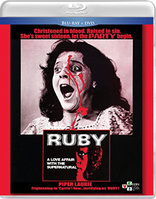
Movie rating
5.1 | / 10 |
Blu-ray rating
| Users | 3.0 | |
| Reviewer | 2.0 | |
| Overall | 2.2 |
Overview
Ruby (1977)
Sixteen years after Ruby Claire's gangster boyfriend was shot and killed by four associates, a series of gruesome murders takes place at the drive-in movie theatre she now owns. Meanwhile, the behaviour of her mute daughter Leslie is becoming increasingly strange and a visiting psychic claims that forces from beyond are out for revenge.
Starring: Piper Laurie, Stuart Whitman, Roger Davis (II), Janit Baldwin, Crystin SinclaireDirector: Curtis Harrington
| Horror | Uncertain |
| Drama | Uncertain |
Specifications
Video
Video codec: MPEG-4 AVC
Video resolution: 1080p
Aspect ratio: 1.85:1
Original aspect ratio: 1.85:1
Audio
English: LPCM 2.0 (48kHz, 16-bit)
Subtitles
English SDH
Discs
Blu-ray Disc
Two-disc set (1 BD, 1 DVD)
DVD copy
Playback
Region A (B, C untested)
Review
Rating summary
| Movie | 2.0 | |
| Video | 2.0 | |
| Audio | 3.5 | |
| Extras | 3.0 | |
| Overall | 2.0 |
Ruby Blu-ray Movie Review
Reviewed by Jeffrey Kauffman September 20, 2017In our Going Clear: Scientology and the Prison of Belief Blu-ray review I mentioned that there were some perhaps unexpected connections between L. Ron Hubbard and famed occultist Aleister Crowley, that very connection potentially making some already wary of Hubbard’s purported “religion” even more trepidatious about it. There are also some really interesting connections between Crowley, Hubbard and Hollywood Babylon author Kenneth Anger that also include director (and occasional actor) Curtis Harrington which I’ll leave to the enterprising Googler to discover, with one locus being actress Marjorie Cameron, who appeared in two of Harrington’s early films, The Wormwood Star (evidently a documentary about Cameron) and Night Tide (my colleague Casey Broadwater provides some interesting data points about Harrington and Anger in his Night Tide Blu-ray review). Despite any “magickal” (as Crowley would have spelled it) proclivities, Harrington had at best a spotty track record in Hollywood, offering at least one pretty interesting effort (1967’s Games, which featured an early star turn from James Caan), but gaining most of whatever reputation he was able to muster from a trifecta of similarly named features from the early seventies whose very titles were themselves obvious homages to Robert Aldrich’s iconic What Ever Happened to Baby Jane?, the 1970 made for television feature How Awful About Allan, and two 1971 theatrical entries, What's the Matter with Helen? and Who Slew Auntie Roo?. Harrington was nearing the end of his fitful feature film directing career when he helmed Ruby in 1977, a film which evokes a different iconic horror film than the Aldrich opus, namely William Friedkin’s The Exorcist (with perhaps just a few hints of Richard Donner’s The Omen thrown in for good measure). Ruby is an odd aggregation of elements by any measure, and it never really works up much fear factor, despite Harrington trying to ape certain Exorcist tropes like a young girl speaking in a gravelly voice or twisting herself into pretzel like shapes that would confound any yoga teacher.
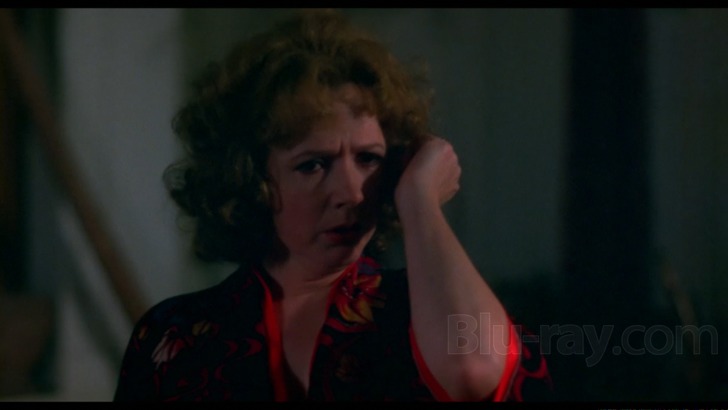
The film begins in the 1930s, in what the commentary by David Del Valle and Nathaniel Bell states was one of Harrington’s favorite milieus, though it doesn’t stay there for very long. Ruby Claire (Piper Laurie) is a gangster’s moll, with the gangster being Nicky Rocko (Sal Vecchio). In a plot point which really doesn’t make a ton of sense and which is only fitfully addressed in some brief narration, Nicky’s gang shoots him dead, a horrifying attack which leaves the pregnant Ruby going into labor as a result of her shock. This opening sequence is unclearly presented from a number of angles, including purely visual, with overarching darkness and a lot of soft focus photography, perhaps to help “smooth” the idea that Ruby is a young woman. That lack of clarity only continues once the story segues forward a decade and a half give or take to find that Ruby has gone into business running a drive in theater (in just one of several completely outré plot points), and, even stranger given the fact that they killed her former lover, is employing several of Nicky’s former gang members.
Some of those gang members start showing up dead in various horrifying ways, but the film keeps going off on totally bizarre tangents like Ruby’s imaginary performances at a kind of “personal stage” she has in her home. There’s also the completely weird character of Jake (Fred Kohler, Jr.), a blind and wheelchair bound man who is tethered to Ruby in some quasi-romantic way (it was never completely clear to me, as with a number of other things in the film), and whom Ruby seems to delight in tormenting. Also on tap is drive-in worker Vince Kemper (Stuart Whitman), who also seems to have a thing either for or with Ruby, and to whom Ruby turns when other employees show up dead and Ruby needs someone to get rid of them. There’s some passing dialogue about something in the past that ties Ruby and Vince together, but as with so much else in the film, it’s left largely unexplained and/or unexplored.
The weirdest character, though, is probably Ruby’s daughter Leslie (Janit Baldwin), the girl who was born the night Nicky was murdered and who as a teenager traipses around in a nightgown but who never utters a word. Well, not for a while, anyway — because soon enough it appears that the spirit of Nicky has taken over Leslie and she begins exhibiting some very Exorcist-like behavior. That leads to Vince bringing in a handy therapist he just happens to know, a guy named Paul Keller (Roger Davis), who tries to get through to Leslie via some of the least convincing film hypnotism ever.
Ruby might be enjoyed by some as a prime example of “so bad it’s good”, since the film has an almost ADHD sensibility, darting from gruesome death to Ruby belting out a tune in her supposed nightclub. There’s a certain hilarity to having something completely extraordinary happen, like Leslie bending into one of those aforementioned pretzel shapes, and then Ruby just donning her bright red housecoat and coming on to Vince for no apparent reason. Once Leslie is under the sway of Nicky, there’s also an unintentionally comic scene between Leslie and Ruby with Leslie making the moves on her mother. It’s all just so patently odd that it’s hard to describe, but even with its freak flag flying high (so to speak), Ruby never truly scares and probably doesn’t even successfully navigate what was evidently Harrington’s original vision, a kind of doomed love ghost story.
In some interesting comments contained on the inside of the insert, commentator Nathaniel Bell freely admits Ruby is at least partially a failure, and he also rightly points out how underwritten almost all of the characters are, as well as plot points that are (in his words) "confounding". There's still a weird kind of "train wreck" quality to this film that may recommend it to some, but unfortunately the "magick" just wasn't with Harrington on this particular project.
Ruby Blu-ray Movie, Video Quality 
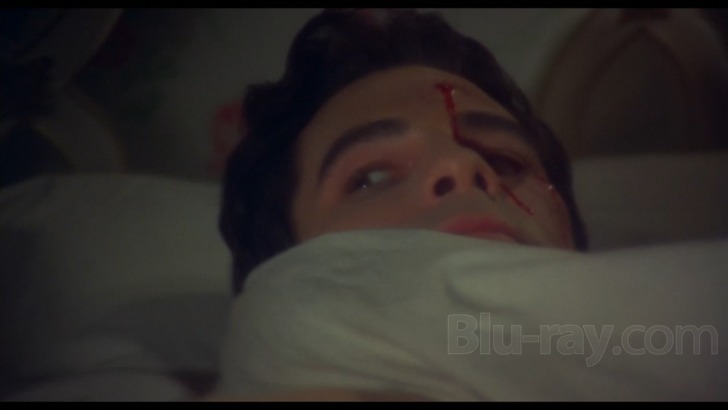
Ruby is presented on Blu-ray courtesy of MVD Visual and VCI Entertainment with an AVC encoded 1080p transfer in 1.85:1. I wish I had
better news about this transfer, since for whatever reason Ruby has engendered a certain fondness in some horror fans, but there are some
fairly noticeable problems throughout this presentation. Both online data and the back cover of this release state that this was a new 2K film
transfer from the original 35mm negative (for what it's worth, a member has posted on our Forum that the negative was never found and this was
sourced off of a print). I'll simply say that to my eyes if this was indeed sourced off of the negative, that there are some
recurrent issues here that suggest either a compromised source or perhaps that
something may have gone wrong at some stage in the scanning, encoding or "restoration" process. While I have nothing other than my eyes to
back this up,
I'll simply say that there are anomalies here that at least resemble interlacing and/or upscaling (and to clarify, I'm just trying to describe their
appearance, I'm not specifying their cause), due to some issues I'll offer specific
examples of. Combing artifacts and stairstepping are readily noticeable from the get go on the Dimension Pictures logo and on the Steve Krantz
credit, as well as on the white
"identifying subtitles" that occur both before and after the actual credits sequence. Aside from typefaces, though, I'll simply point you to a few
screenshots included with this
review to let you see what I'm talking about. First of all take a look at screenshots 5 and 10, and notice the clearly visible parallel vertical lines
running
through the entirety of the Attack of the 50 Foot Woman frames. That might be attributable to whatever source for that film was
used, but now look at screenshot 8, and you'll notice the same anomaly clearly visible in the Ruby's Drive In sign. In screenshot 15, it's noticeable
again, probably mostly in the pearls hanging on the picture of Nicky. I initially thought this might be due to the master having been cobbled
together
from different elements due to the film having been cut and altered in post production, but these anomalies are so recurrent that I'm frankly
uncertain how to
account for them and am therefore merely pointing them out. Freeze framing any given moment in this film reveals "jaggies" regularly poking out
of the edges of various elements, typically as close cropped parallel vertical lines, including everything from hair to sets. Putting aside this
particular problem, though, the transfer is also hobbled by two
other seemingly conflicting issues. On one hand, some
scenes seem to have been pretty aggressively filtered, with a near absence of grain, while other moments do have something approaching
a
grain field, though compression often makes it pretty clumpy and even pixellated looking (you can see some of this tendency in screenshot 8 again,
especially toward the right side of the frame). The entire transfer is on the soft side (some of which is inherent, since I'm fairly certain Harrington
used
soft focus on Laurie quite a bit of the time), and there are murky brightness levels that lead to a lot of crush in the many dark scenes. The best
thing
about this transfer is its palette reproduction, with the many red tones utilized, especially in Ruby's costumes, popping rather vividly, though even
here a certain yellowish tinge attends a lot of the presentation. Despite
whatever restoration was undertaken, there are still quite a few signs of age related wear and tear.
Update: I hadn't seen this before I posted the review since it was in a separate thread not linked to this title, and it's a little unclear to me
exactly which title is being referred to (since the thread is about several), but VCI is evidently aware of
something like the anomaly detailed above with regard to One
Million B.C. and is working on a replacement program. VCI's Bob Blair has posted about it
here.
Update 2: Mr. Blair has also mentioned something that I kind of hilariously assumed was supposed to be the way it was, with an odd fade
out at one point. It's evidently a mistake, and Mr. Blair addresses it
here.
Ruby Blu-ray Movie, Audio Quality 
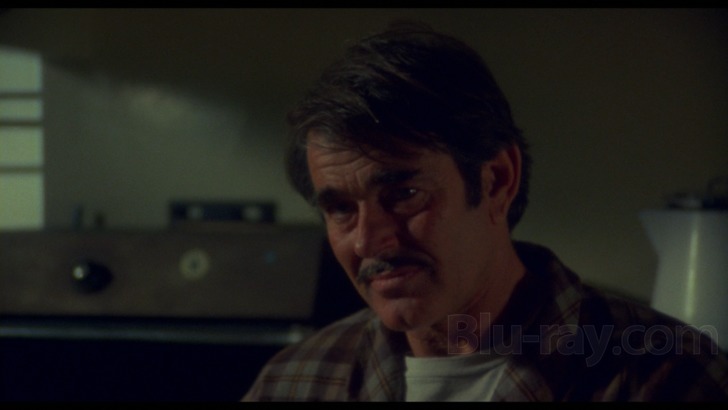
Heinz Roemheld provided a memorable title tune for Ruby Gentry, and decades later Helen Reddy would have a substantial pop hit with a tune called "Leave Me Alone (Ruby Red Dress)", but Ruby's score by jazzman Don Ellis is not one of his more hummable offerings. The music nonetheless is one of the more ubiquitous elements on the LPCM 2.0 track included on this release, and while the music itself may not win any awards, it sounds reasonably full bodied. Dialogue is rendered cleanly, but sounds a trifle boxy at higher amplitudes (as when Laurie goes into hyperbolic mode and begins yelling, again for no apparent reason).
Ruby Blu-ray Movie, Special Features and Extras 

- Commentary with David Del Valle and Nathaniel Bell provides a lot of interesting information, especially about Curtis Harrington, but Del Valle is awfully hard to hear at times.
- Commentary with Curtis Harrington and Piper Laurie is an interesting if somewhat sporadic archival piece that includes some interesting comments from Laurie about her work in Carrie.
- Ruby Original Trailer (1080p; 2:26)
- 2001 David Del Valle Interview with Curtis Harrington (1080p; 59:04) covers a lot of ground but is marred by some pretty serious audio sync issues.
- Sinister Image Episode Volume 1: David Del Valle Archival Interview with Curtis Harrington (1080p; 28:06) gets into Harrington's early life and career. This also has audio sync issues, but less so than the preceding supplement. It also appears to be an upscale.
- Sinister Image Episode Volume 2: David Del Valle Archival Interview with Curtis Harrington (1080p; 29:00) deals more with Harrington's career from the late sixties onward, including some interesting information about Games. This still has some slight audio sync problems and, like the other episode, appears to be an upscale.
Ruby Blu-ray Movie, Overall Score and Recommendation 
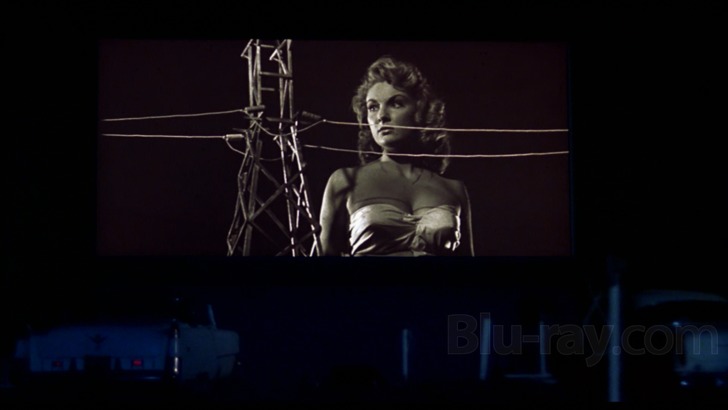
I have friends who love Ruby, though even they tend to laugh at its more florid moments. This is one completely odd motion picture in any number of ways, and unfortunately its technical presentation has some issues that make it even odder. The supplemental package may be the real selling point here, but even some of the supplements have audio sync issues.
Similar titles
Similar titles you might also like

3 from Hell 4K
2019

Sometimes They Come Back
1991

Hatchet III
2013

The Devil Doll
Warner Archive Collection
1936

Baron Blood
Gli orrori del castello di Norimberga
1972

Death Bed: The Bed That Eats
1977

Father's Day
2011

Black Sabbath
AIP Cut | 60th Anniversary
1963

Black Friday
1940

The Black Phone
Collector's Edition
2021

Ghost Stories
2017

Wicked Little Things
2006

I Spit on Your Grave 4K
Day of the Woman
1978

Girl on the Third Floor
2019

The Amityville Murders
2018

Scary Stories to Tell in the Dark 4K
2019

Marrowbone
The Secret of Marrowbone
2017

Satan's Children
Slipcover in Original Pressing
1975

Igor and the Lunatics
Slipcover in Original Pressing
1985

Welcome Home Brother Charles
Soul Vengeance
1975
